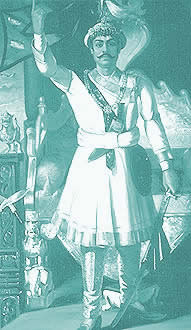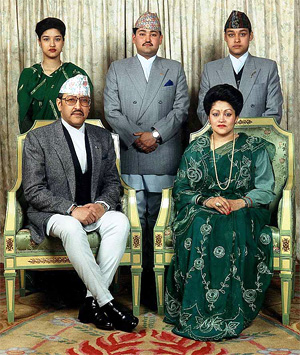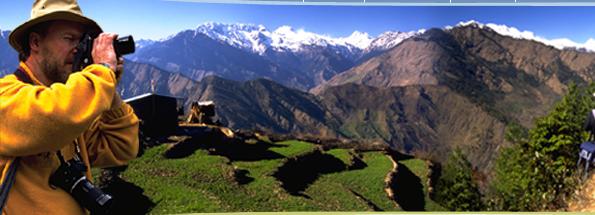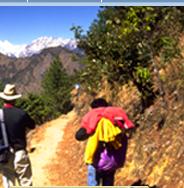Nepal has a long glorious history.
Its civilization can be traced back to thousands of
years before  the
birth of Christ. History reveals dynasties of Ahirs
and Gopalas, Kirants, Licchavis and Thakuris ruling
the country before the Malla period began. Modern Nepal
is an amalgamation of a number of principalities which
had independent entities in the past. Before the campaign
of national integration launched by King Prithivi Narayan
Shah – the first Shah King of Nepal, Kathmandu
valley was ruled by the Malla Kings, whose contribution
to arts and culture are indeed great and the Malla era
is considered to be the golden age of Nepal. In 1768
A.D., the Shah King defeated the Malla Kings and unified
the country that was divided into small independent
Kingdoms. the
birth of Christ. History reveals dynasties of Ahirs
and Gopalas, Kirants, Licchavis and Thakuris ruling
the country before the Malla period began. Modern Nepal
is an amalgamation of a number of principalities which
had independent entities in the past. Before the campaign
of national integration launched by King Prithivi Narayan
Shah – the first Shah King of Nepal, Kathmandu
valley was ruled by the Malla Kings, whose contribution
to arts and culture are indeed great and the Malla era
is considered to be the golden age of Nepal. In 1768
A.D., the Shah King defeated the Malla Kings and unified
the country that was divided into small independent
Kingdoms.
His Majesty King Gyanendra Bir Bikram Shah Dev is the
present King of Nepal. The revolution of November 1950
brought an end to autocratic Rana regime that ruled
the country for 104 years since 1846 A.D. The Ranas
seized all the power from the Shahs but revered the
existence of King in Nepal. After the fall of Ranas
in February 1951, Nepal first saw a dawn of democracy.
The parliamentary government under the multi-party system
was adopted for some years which was later followed
by Panchayat System in 1960. The popular people’s
movement of 1990 reinstated the multi party democratic
system and the new democratic constitution of the Kingdom
was promulgated on November 9, 1990. On February 1,
2005, King Gyanendra made another historic move and
assuming all executive powers headed a 10 member cabinet
with the commitment and assurance to bring back the
lost PEACE in the country within the next three years.
Nepal is one of the founding members of South Asian
Association for Regional Cooperation (SAARC) which was
formed in December 1985. The SAARC Secretariat was set
up in Kathmandu in January 1987 and later in the same
year in November, third SAARC summit was held in Kathmandu.
Late King Birendra Bir Bikram Shah Dev ruled Nepal
for 30 years from January 30, 1971 to June 1, 2001.
His son Crown Prince Dipendra was named King on June
2, 2001, after the unfaithful Royal family massacre
of June 1, 2001 that took the lives of the King, Queen,
Prince, Princess and five other Royal family members.
But King Dipendra soon died in hospital on June 4, 2001.
The younger brother of late King Birendra, His Majesty
King Gyanendra Bir Bikram Shah Dev was accessioned to
throne on June 4, 2001 and currently rules the country.
He is the twelfth King in the Shah dynasty.
 During
a regular gathering at Narayanhity Royal Palace on the
Friday night of June 1, 2001, the gathered Royal family
members were shot dead and some were injured within
a few minutes of time by Crown Prince Dipendra, who
was heavily under the influence of alcohol and drugs.
Crown Prince Dipendra also shot himself in an attempt
of suicide over an argument he had with his parents
about the woman he wanted to marry. Crown Prince Dipendra
was admitted to hospital in a coma and critically wounded
condition, but still was named the King. During
a regular gathering at Narayanhity Royal Palace on the
Friday night of June 1, 2001, the gathered Royal family
members were shot dead and some were injured within
a few minutes of time by Crown Prince Dipendra, who
was heavily under the influence of alcohol and drugs.
Crown Prince Dipendra also shot himself in an attempt
of suicide over an argument he had with his parents
about the woman he wanted to marry. Crown Prince Dipendra
was admitted to hospital in a coma and critically wounded
condition, but still was named the King.
The King in Nepal is seen as a Living God, the reincarnation
of Lord Vishnu. Late King Birendra was very popular
and deeply loved by the people of Nepal who were greatly
shocked and saddened by the news and it took quite a
long time for the countrymen to come out from their
self mourning.
The King, Queen and other members of the Royal family
were carried to Pashupati Aryaghat, next to the Holy
Bagmati River, for their last rites. Desperate to know
the truth, people blocked traffic in protest and riots
began in the streets of Kathmandu and even curfew had
to be imposed to disperse the restless crowd which just
could not believe what had happened inside the highly
guarded Royal Palace.
People shaved their heads as a sign of respect for
their beloved King as they would have done in the demise
of their family members as per Hinduism and a 5 day
closure of government offices and 13 days of official
mourning was announced. Just after 48 hours of the title
“King”, King Dipendra died in the hospital
and the younger brother of late King Birendra, Prince
Gyanendra became the new King of Nepal - three Kings
in 4 days.
The murder of Royals inside Narayanhity Royal Palace
is said to be the second worst mass killing of royalty
in the world after the Romanovs, who were killed back
in 1918 during the Russian civil war.
|





 the
birth of Christ. History reveals dynasties of Ahirs
and Gopalas, Kirants, Licchavis and Thakuris ruling
the country before the Malla period began. Modern Nepal
is an amalgamation of a number of principalities which
had independent entities in the past. Before the campaign
of national integration launched by King Prithivi Narayan
Shah – the first Shah King of Nepal, Kathmandu
valley was ruled by the Malla Kings, whose contribution
to arts and culture are indeed great and the Malla era
is considered to be the golden age of Nepal. In 1768
A.D., the Shah King defeated the Malla Kings and unified
the country that was divided into small independent
Kingdoms.
the
birth of Christ. History reveals dynasties of Ahirs
and Gopalas, Kirants, Licchavis and Thakuris ruling
the country before the Malla period began. Modern Nepal
is an amalgamation of a number of principalities which
had independent entities in the past. Before the campaign
of national integration launched by King Prithivi Narayan
Shah – the first Shah King of Nepal, Kathmandu
valley was ruled by the Malla Kings, whose contribution
to arts and culture are indeed great and the Malla era
is considered to be the golden age of Nepal. In 1768
A.D., the Shah King defeated the Malla Kings and unified
the country that was divided into small independent
Kingdoms. During
a regular gathering at Narayanhity Royal Palace on the
Friday night of June 1, 2001, the gathered Royal family
members were shot dead and some were injured within
a few minutes of time by Crown Prince Dipendra, who
was heavily under the influence of alcohol and drugs.
Crown Prince Dipendra also shot himself in an attempt
of suicide over an argument he had with his parents
about the woman he wanted to marry. Crown Prince Dipendra
was admitted to hospital in a coma and critically wounded
condition, but still was named the King.
During
a regular gathering at Narayanhity Royal Palace on the
Friday night of June 1, 2001, the gathered Royal family
members were shot dead and some were injured within
a few minutes of time by Crown Prince Dipendra, who
was heavily under the influence of alcohol and drugs.
Crown Prince Dipendra also shot himself in an attempt
of suicide over an argument he had with his parents
about the woman he wanted to marry. Crown Prince Dipendra
was admitted to hospital in a coma and critically wounded
condition, but still was named the King.